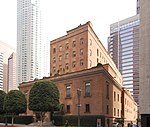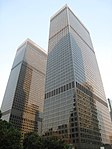First Interstate Tower fire
1988 disasters in the United States1988 fires1988 in Los AngelesBuilding fires in the United StatesCommercial building fires ... and 4 more
Disaster stubsFires in CaliforniaHigh-rise firesMay 1988 events in the United States

The First Interstate Tower fire was a high-rise fire that occurred on May 4, 1988, at the First Interstate Tower (now Aon Center) in Los Angeles, California, a 62-story, 860 foot (260 m) skyscraper, then the tallest building in the city. The fire destroyed five floors of the building, injured 40 people, and caused the death of a maintenance worker, when the elevator he was riding opened onto the burning 12th floor.
Excerpt from the Wikipedia article First Interstate Tower fire (License: CC BY-SA 3.0, Authors, Images).First Interstate Tower fire
South Hope Street, Los Angeles Downtown
Geographical coordinates (GPS) Address Nearby Places Show on map
Geographical coordinates (GPS)
| Latitude | Longitude |
|---|---|
| N 34.049222222222 ° | E -118.25713888889 ° |
Address
Aon Center
South Hope Street
90015 Los Angeles, Downtown
California, United States
Open on Google Maps








